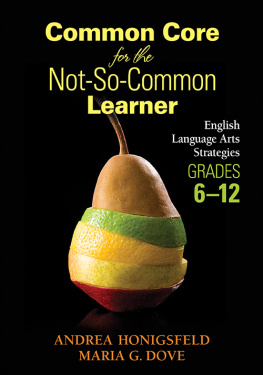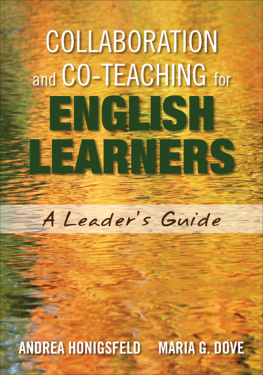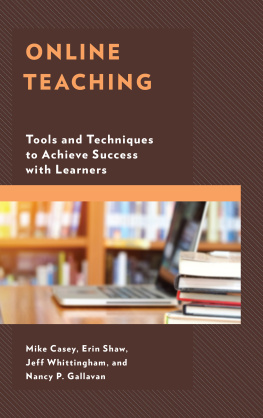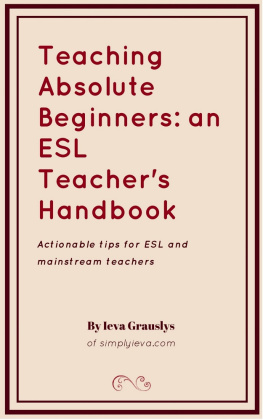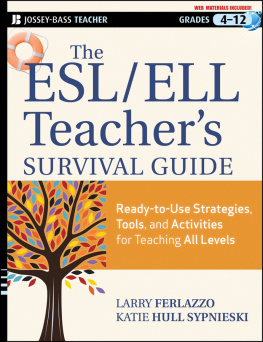Andrea M. Honigsfeld - Collaboration and Co-Teaching: Strategies for English Learners
Here you can read online Andrea M. Honigsfeld - Collaboration and Co-Teaching: Strategies for English Learners full text of the book (entire story) in english for free. Download pdf and epub, get meaning, cover and reviews about this ebook. City: SAGE Publications, year: 2013;2010, publisher: SAGE Publications, genre: Religion. Description of the work, (preface) as well as reviews are available. Best literature library LitArk.com created for fans of good reading and offers a wide selection of genres:
Romance novel
Science fiction
Adventure
Detective
Science
History
Home and family
Prose
Art
Politics
Computer
Non-fiction
Religion
Business
Children
Humor
Choose a favorite category and find really read worthwhile books. Enjoy immersion in the world of imagination, feel the emotions of the characters or learn something new for yourself, make an fascinating discovery.

- Book:Collaboration and Co-Teaching: Strategies for English Learners
- Author:
- Publisher:SAGE Publications
- Genre:
- Year:2013;2010
- City:SAGE Publications
- Rating:3 / 5
- Favourites:Add to favourites
- Your mark:
- 60
- 1
- 2
- 3
- 4
- 5
Collaboration and Co-Teaching: Strategies for English Learners: summary, description and annotation
We offer to read an annotation, description, summary or preface (depends on what the author of the book "Collaboration and Co-Teaching: Strategies for English Learners" wrote himself). If you haven't found the necessary information about the book — write in the comments, we will try to find it.
This resource provides strategies and tools for using collaboration and co-teaching between general education teachers and ESL specialists to better serve the needs of English learners.
Collaboration and Co-Teaching: Strategies for English Learners — read online for free the complete book (whole text) full work
Below is the text of the book, divided by pages. System saving the place of the last page read, allows you to conveniently read the book "Collaboration and Co-Teaching: Strategies for English Learners" online for free, without having to search again every time where you left off. Put a bookmark, and you can go to the page where you finished reading at any time.
Font size:
Interval:
Bookmark:
Strategies for English Learners
This easy-to-read book empowers educators to work collaboratively in planning and teaching to meet the needs of English language learners in co-taught classrooms. This book makes a contribution toward successfully educating students in diverse classrooms.
Richard Andrew Villa, President, Bayridge Consortium, Inc.
Honigsfeld and Dove have written a comprehensive book on collaboration between mainstream and ESL teachers. This is an essential read for teachers and administrators who wish to effectively implement collaborative strategies that benefit ELLs in their schools.
Judie Haynes, Professional Development Provider, EverythingESL.net
This book is a road map for collaborative practice with a focus on English language learners. The vignettes offer a window into the complex and diverse challenges of teaching in linguistically and culturally diverse contexts. The what, when, where, how, and why of collaborative practice are discussed, and the book provides valuable online resources and helpful references for further research and exploration.
Dorit Kaufman, Professor of Linguistics, Director of Professional Educational Program, Stony Brook University, NY
This text is a guide to successful practice, from laying the initial groundwork, to classroom and curriculum planning, to administrative and school design, to evaluation design, with examples and forms that can be utilized by the reader throughout. The authors present a realistic look, with optimism for this exciting venture of collaboration and co-teaching in the context of ELLs, as well as challenges and pitfalls, but always with helpful solutions.
Jana Noel, Professor and Community Engagement Faculty Scholar, California State University, Sacramento
This groundbreaking book provides a strong foundation for both teachers and administrators who want to establish more supportive, inclusive learning environments for their English language learners. This research-based work explores the many facets of collaboration and provides the reader with the tools to begin co-teaching. Its practical ideas and questions help teachers move collaboration and co-teaching to the next level.
Heidi Bernal, Director, English Language Learner Department, Saint Paul Public Schools, MN
Through intriguing questions and illustrative vignettes, Honigsfeld and Dove masterfully guide us in understanding the essentials of collaboration when planning, implementing, and assessing instruction for students who are acquiring English as an additional language. A must-read for educators wishing to create a professional leaning community where insights about ESL instruction can be shared.
Diane Lapp, Distinguished Professor of Education, San Diego State University, CA
This important book fills a critical need for current information about the collaborative process and should be in every educators professional library.
Scott W. C. Lawrence, Director of Curriculum, East Granby Public Schools, CT
We dedicate this book to all educators who are committed to working with English language learners. We also dedicate this book to our respective families who are our daily inspirations, Howie, Benjamin, and Jake; Tim, Dave, Jason, Christine, Sara, and Meadow Rose.
Collaboration
and
Co-Teaching
Collaboration
and
Co-Teaching
STRATEGIES FOR
ENGLISH LEARNERS
ANDREA HONIGSFELD
MARIA G. DOVE
Foreword by Margo DelliCarpini

Copyright 2010 by Corwin
All rights reserved. When forms and sample documents are included, their use is authorized only by educators, local school sites, and/or noncommercial or nonprofit entities that have purchased the book. Except for that usage, no part of this book may be reproduced or utilized in any form or by any means, electronic or mechanical, including photocopying, recording, or by any information storage and retrieval system, without permission in writing from the publisher.
For information:
 | Corwin A SAGE Company 2455 Teller Road Thousand Oaks, California 91320 (800) 233-9936 Fax: (800) 417-2466 www.corwin.com | SAGE India Pvt. Ltd. B 1/I 1 Mohan Cooperative Industrial Area Mathura Road, New Delhi 110 044 India |
| SAGE Ltd. 1 Olivers Yard 55 City Road London EC1Y 1SP United Kingdom | SAGE Asia-Pacific Pte. Ltd. 33 Pekin Street #02-01 Far East Square Singapore 048763 |
Printed in the United States of America.
Library of Congress Cataloging-in-Publication Data
Honigsfeld, Andrea, date
Collaboration and co-teaching: strategies for English learners / Andrea Honigsfeld and Maria G. Dove.
p. cm.
Includes bibliographical references and index.
ISBN 978-1-4129-7650-3 (pbk.: alk. paper)
1. English languageStudy and teachingForeign speakers. 2. Language artsAbility testing.
3. Curriculum planning. 4. LiteracyEvaluation. I. Dove, Maria G. II. Title.
| LB1576.H635 2010 | |
| 428.24dc22 | 2010008587 |
This book is printed on acid-free paper.
10 11 12 13 14 10 9 8 7 6 5 4 3 2 1
| Acquisitions Editor: | Dan Alpert |
| Associate Editor: | Megan Bedell |
| Editorial Assistant: | Sarah Bartlett |
| Production Editor: | Cassandra Margaret Seibel |
| Copy Editor: | Mark Bast |
| Typesetter: | C&M Digitals (P) Ltd. |
| Proofreader: | Theresa Kay |
| Cover Designer: | Michael Dubowe |
Contents
Foreword
I f you are reading this book, there is a good chance that you are a teacher, teacher educator, or administrator who has asked a question: How can we better serve the English language learners in our PreK12 grade settings? While this is a complex and multifaceted issue, Andrea Honigsfeld and Maria Dove take a brilliant step toward providing an answer that makes sense and can be implemented in a number of different contexts.
It is well documented that U.S. schools are experiencing rapid growth in terms of the number of students whose native language is not English. In fact, the data show that enrollment in public schools in the United States for ESL students between the years 1991 and 2000 grew by 105 percent, compared to a 12 percent overall growth rate among the general school population (Kindler, 2002). Combined with this is the fact that many general-education teachers, who are specialists in their specific disciplines, are often underprepared to work with ELLs in the general-education classroom, and ESL teachers, while specialists in TESOL (Teaching English to Speakers of Other Languages) pedagogy and theory, often are not aware of the actual curricular demands placed on ELLs in general education. In fact, research has found that only 26 percent of teachers reported taking part in professional development that addresses issues of ELLs (NCES, 2001). In addition, only 27 percent of teachers report being very well prepared to work with ELLs in the general-education classroom (U.S. Department of Education, NCES, 2001). There is usually some requirement in teacher education programs that involves understanding the needs of ELLs, but research tells us that only 20 percent of programs offer a specific course on this topic (U.S. Government Accountability Office, 2009). Finally, the acquisition of the academic language needed, Cognitive Academic Language Proficiency, as Cummins (1979) names it, takes years to acquire. Students entering school and simultaneously acquiring language and content skills, under the best of circumstances, can take seven to ten years to develop this type of language, depending on their level of academic preparation upon entering school as a second- or additional-language learner (Collier & Thomas, 1989). Combined with the aforementioned growth in the ELL population and the level of preparedness among teachers who have ELLs in their general-education classrooms, it seems that we might be reaching a tipping point in terms of providing the most effective service to students who need both to be successful in their general education, content classes and acquire English as an additional language, both for social and academic purposes. While ESL teachers are in the best position to build these language skills in a highly contextualized and sheltered setting, such as a pull-out ESL program, the content or general-education teacher is the one qualified to deliver the discipline-specific material. In a traditional pull-out program, these activities take place in isolation from each other and may not be connected to the extent that they need to be. As a teacher educator who works with both ESL and content-area teachers, I have often heard the lament from the subject area teacher:
Font size:
Interval:
Bookmark:
Similar books «Collaboration and Co-Teaching: Strategies for English Learners»
Look at similar books to Collaboration and Co-Teaching: Strategies for English Learners. We have selected literature similar in name and meaning in the hope of providing readers with more options to find new, interesting, not yet read works.
Discussion, reviews of the book Collaboration and Co-Teaching: Strategies for English Learners and just readers' own opinions. Leave your comments, write what you think about the work, its meaning or the main characters. Specify what exactly you liked and what you didn't like, and why you think so.

